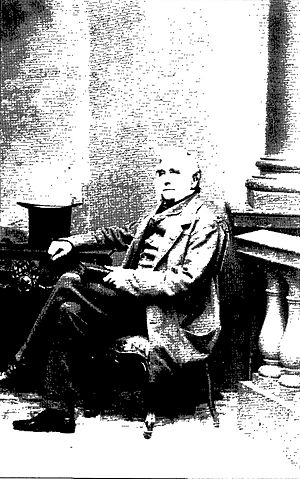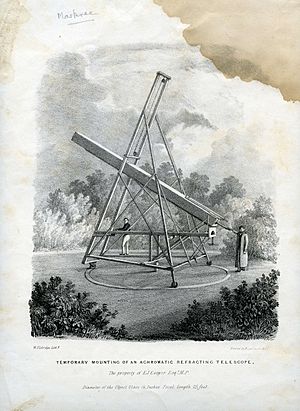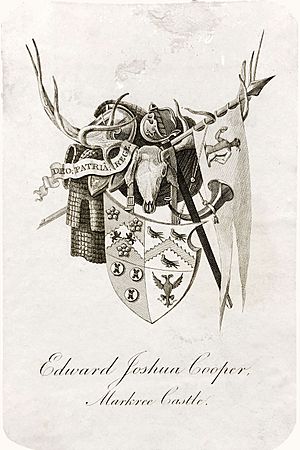Edward Joshua Cooper facts for kids
Edward Joshua Cooper (born May 1798 – died 23 April 1863) was an important Irish landowner, politician, and astronomer. He lived at Markree Castle in County Sligo, Ireland. He served in the House of Commons of the United Kingdom (like a parliament) for a few years. However, he is best known for his passion for astronomy and for creating the famous Markree Observatory.
His observatory was home to the largest refracting telescope (a telescope that uses lenses) in the 1830s. It had a huge lens, almost 14 inches wide, which was the biggest in the world at that time! An asteroid called 9 Metis was discovered there in the 1840s by his assistant. The observatory also helped create several important star catalogs in the 1800s.
Early Life and Family
Edward Joshua Cooper was the oldest son of Edward Synge Cooper, who was also a Member of Parliament. His mother was Anne Verelst.
He went to school at The Royal School, Armagh, then Eton College, and later Christ Church, Oxford university.
Edward Cooper married twice. His first wife was Sophia L'Estrange, but they did not have any children. With his second wife, Sarah Frances Wynne, he had five daughters.
Amazing Astronomy Work
Edward Cooper left Oxford after two years without finishing his degree. He spent about ten years traveling around the world. He loved astronomy, and it's thought his mother encouraged this interest. He also visited the Armagh Observatory when he was a schoolboy.
During his travels, he carried portable astronomy tools. He used them to figure out the exact locations (latitudes and longitudes) of the places he visited. He wanted to see which spots would be best for looking at the stars. He gathered a lot of information about geography, but he never published it.
His early trips took him to places like the Mediterranean, Egypt, Turkey, and Persia. Later, he explored Denmark, Sweden, and Norway, even reaching the very northern tip called North Cape, Norway. He thought that Munich (in Germany) and Nice (in France) were the best places in Europe for observing the sky.
When his father passed away in 1830, Edward took over managing Markree Castle. Once he was in charge, he started building special facilities for astronomy. This became the famous Markree Observatory.
In 1831, he bought a huge lens for £1200. It was the largest telescope lens in the world at that time! This lens was made by a French expert named Robert-Aglaé Cauchoix. It was about 13.33 inches (33.86 cm) wide and had a focal length of 25 feet (7.62 meters).
At first, the telescope was on a wooden stand. But a friend, Dr. Thomas Romney Robinson, suggested a better way. The telescope was then mounted by Thomas Grubb of Dublin. This was special because it used a strong cast iron tube and stand, instead of wood. This was the first big job for Grubb, who later became famous for making telescopes worldwide. Because the telescope was so big, they couldn't build a dome for it, so it stayed outside.
Cooper used this powerful telescope to draw Halley's Comet in 1835 and to watch a solar eclipse in 1836.
The observatory grew over time. By 1851, people said Markree was "undoubtedly the most richly furnished of private observatories."
In 1842, an assistant named Andrew Graham joined Cooper. Together, they worked hard to record the exact positions of many stars. Graham also started regularly observing minor planets.
They even used rockets to figure out the exact location of Markree! In 1841, rockets were fired from Culkagh Mountain, and both Markree and Armagh observatories watched them. This helped them precisely calculate Markree's position. Later, in 1847, they used shooting stars to measure the distance between Markree and Killiney in County Dublin.
A very exciting discovery happened on 25 April 1848. Andrew Graham used a special "comet-seeker" telescope at Markree to find a new minor planet! It was the ninth minor planet ever discovered. It was named "9 Metis". This was the only asteroid ever found by observation from Ireland for a long time.
Edward Cooper also kept detailed weather records at Markree for thirty years. He also traveled through Europe with his telescope, sketching things like the Orion nebula. He even discovered a comet independently in 1845.
Cooper and Graham worked on creating a huge star catalog. They observed over 60,000 stars near the ecliptic (the path the sun appears to follow in the sky). Most of these stars had never been recorded before! This was a massive help for astronomers. For this important work, Cooper received a special gold medal in 1858.
Cooper also studied comets. He gathered information about 198 comets and published a book called 'Cometic Orbits' in 1852. This book was a very useful guide for other astronomers.
In 1852, he discovered a star in the constellation Pisces, which he mistakenly thought was a nebula (a cloud of gas and dust in space).
Political Life
In 1830, Edward Cooper became one of the two Members of Parliament (MPs) for Sligo County. His family had held a seat in Sligo for almost a century.
The politics in the county were mainly controlled by big Protestant landowners. Edward Cooper was a Tory. He was re-elected several times without opposition. He eventually stepped down from Parliament in 1841 but returned for another term in 1857.
Later Life and Legacy
Edward Cooper passed away at the age of 64 on 28 April 1863. He was buried in a church in Ballisodare, next to his second wife, Sarah. People remembered him as a kind and helpful landlord. The Cork Examiner newspaper said he was "celebrated for his scientific attainments, moral worth and estimable character."
His nephew, Edward Henry Cooper, inherited his estates. At first, the observatory was not well looked after. But later, it was restored and mainly used for weather studies. When Edward Henry Cooper died in 1902, the observatory closed. Its famous large lens was sent to the Hong Kong Observatory. The observatory's library, full of valuable books, was sadly turned into a garage.
|




